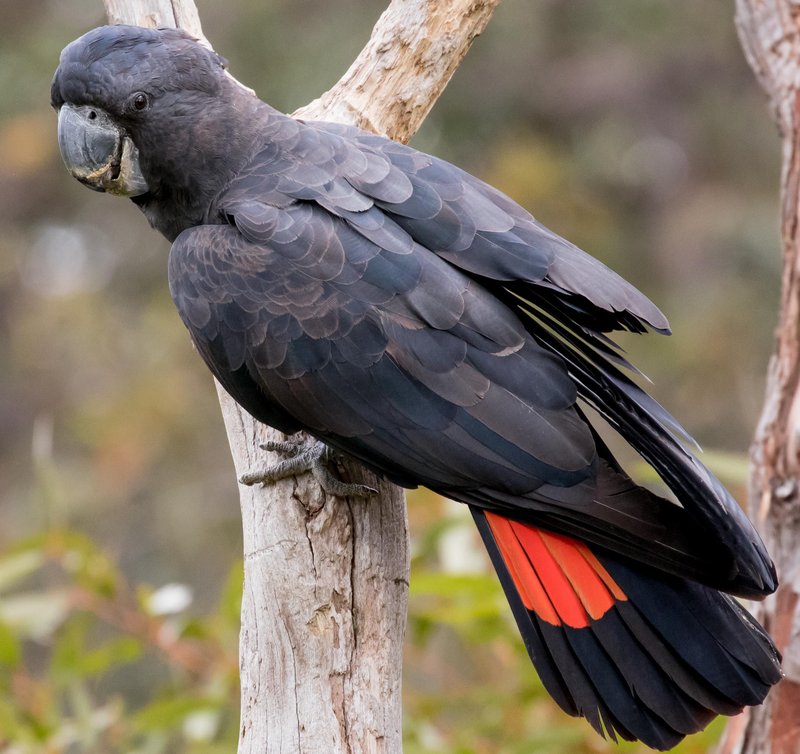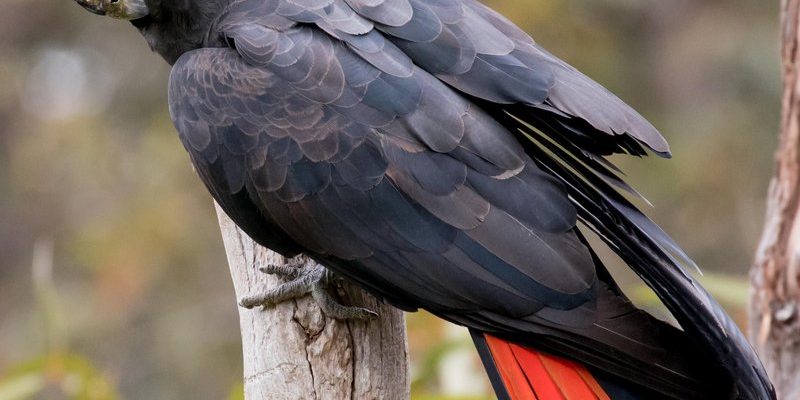
When you think of colorful and charismatic birds, the Black Cockatoo might not be the first one that comes to mind. But, believe it or not, these stunning creatures are not just beautiful; they’re fascinating in many ways. With their striking dark plumage and impressive size, Black Cockatoos are a true highlight in the world of avian wildlife. Imagine a bird that can play a significant role in its ecosystem while also capturing the hearts of bird watchers everywhere. That’s the Black Cockatoo for you!
These magnificent birds are native to Australia and surrounding regions, often found in woodlands and forests. They have a rich history and cultural significance in Indigenous Australian stories. If you’ve ever seen one in flight, you would understand the awe they inspire. Their presence in the wild is not just about their beauty; they are integral to the habitats they inhabit, helping to maintain the balance of their ecosystems.
What is a Black Cockatoo?
The Black Cockatoo refers to several species of cockatoos that share the predominant coloration of black feathers. You’ll commonly see the Glossy Black Cockatoo, Red-tailed Black Cockatoo, and Yellow-tailed Black Cockatoo among the most recognized members of this group. These birds vary in size and behaviors, but they all share that striking dark appearance, which often comes adorned with vibrant accents—like the bright red tail feathers of the Red-tailed Black Cockatoo.
These birds can weigh anywhere from about 400 grams to 1,000 grams, depending on the species. They have an impressive wingspan, reaching up to 1 meter. Despite their size, they have a graceful flight and are often seen gliding smoothly through the treetops. But don’t let that gentle demeanor fool you! Black Cockatoos are known for their strong personalities and intelligence, often displaying playful behaviors and complex social structures.
Physical Characteristics
Black Cockatoos are truly a sight to behold. Most species have a majestic, large body with a strong, curved beak that’s perfectly designed for cracking open tough seeds and nuts. The feathers can appear almost glossy in certain light, giving them a regal look. For example, the Yellow-tailed Black Cockatoo features bold yellow markings under its tail and on the sides of its head, making it quite the showstopper among its peers.
Another fascinating feature is their crest, which can be raised or lowered depending on their mood. When they’re excited or feeling territorial, you might see this crest proudly standing tall. It’s like a visual cue that tells you a bit about what they’re feeling—just like how a dog’s wagging tail can indicate its mood!
Habitat and Range
So where do these birds call home? The Black Cockatoo thrives in forested areas, woodlands, and open bushland. They typically prefer habitats that offer a mix of eucalypt trees and other native flora. Regions across eastern and southern Australia are prime habitat for many species. You’ll also find them in parts of New Guinea and surrounding islands.
Their habitat is important not only for shelter but also for feeding. Black Cockatoos feast on seeds from various trees, including banksias and acacias. This diet plays a crucial role in their ecosystem, as they help disperse seeds, which promotes plant growth and biodiversity. Talk about being an environmental hero!
Diet and Feeding Habits
When it comes to what they eat, Black Cockatoos are primarily seed-eaters. Their strong beaks are specially adapted to crack open hard seed pods and access the nutritious seeds inside. This dietary preference means they often travel in flocks to find food sources. Imagine a group of them swooping down to feast on the seeds scattered on the forest floor—it’s quite a sight!
In addition to seeds, they enjoy fruits, flowers, and even insects on occasion. You might be surprised to learn that some species are known to play a role in pollination while they feed. As they move from flower to flower, they inadvertently aid in the reproduction of various plants. It’s a beautiful example of how interconnected our ecosystems are, where every species plays its part.
Behavior and Social Structure
Black Cockatoos are social creatures. They thrive on interaction, often forming tight-knit family groups or larger flocks. These flocks can be quite vocal, engaging in loud screeches and calls that can echo through the trees. Their communication is not just noise; it serves crucial purposes for bonding, warning others of predators, or coordinating movements when foraging for food.
During breeding season, these birds showcase fascinating courtship behaviors. Males will perform displays that include aerial acrobatics and vocalizations to attract females. Once paired, they form strong bonds and often mate for life. It’s heartwarming to see such dedication in the avian world, where love isn’t just for the birds!
Conservation Status
Unfortunately, many Black Cockatoo species face threats from habitat loss due to deforestation, land clearing, and urban development. Climate change also poses a significant risk, affecting their food supply and nesting sites. Conservation efforts are underway, focusing on habitat restoration and protection, along with awareness programs to educate communities about the importance of these birds.
Several organizations are dedicated to conserving Black Cockatoo populations. Their work involves tracking populations, rehabilitating injured birds, and working with local communities to create safe environments for these stunning creatures. By supporting these initiatives, we can all play a part in ensuring that future generations enjoy the sight and sounds of Black Cockatoos in the wild.
Interesting Facts About Black Cockatoos
| Species | Glossy Black Cockatoo, Yellow-tailed Black Cockatoo, Red-tailed Black Cockatoo |
| Habitat | Woodlands, forests, and open bushland in Australia |
| Size | Approx. 40–60 cm in length |
| Weight | 400–1,000 grams depending on species |
| Diet | Seeds, nuts, fruits, and flowers |
| Lifespan | Around 30–50 years in the wild |
How to Spot a Black Cockatoo
Knowing how to identify a Black Cockatoo can be an exciting challenge, especially if you’re birdwatching in the right areas. Look for them in the treetops, where their dark plumage provides excellent camouflage against the shadows of the forest. They can often be heard before they’re seen, thanks to their distinctive calls. Once you know what to listen for, spotting them becomes much easier!
When observing these birds, pay attention to their size and the unique markings of different species. For example, the Yellow-tailed Black Cockatoo will showcase bright yellow accents, while the Red-tailed variety flaunts its signature vibrant tail. You might also get lucky and witness their social interactions as they dance and call to one another in flight. Just remember—if you see them up close, keep a respectful distance. We want to appreciate these beautiful creatures without disrupting their natural behaviors.
Black Cockatoos in Culture
The significance of Black Cockatoos extends beyond their ecological role. These birds are deeply woven into the cultural fabric of Indigenous Australian stories and traditions. For many Indigenous groups, Black Cockatoos symbolize strength, resilience, and connection to the land. They often feature in art, dance, and song, representing the beauty and complexity of nature.
In addition to traditional stories, contemporary artists and writers continue to celebrate Black Cockatoos, using their imagery to convey messages about conservation and respect for the environment. This cultural reverence helps build a bridge between ecological responsibility and appreciation for these magnificent birds. When you look at a Black Cockatoo, you’re not just seeing a bird; you’re witnessing a symbol of connection and history.
How to Help Black Cockatoos
You might wonder how you can contribute to the conservation of Black Cockatoos—it’s simpler than you think! Start by supporting local conservation efforts, whether volunteering your time, donating to organizations focused on wildlife preservation, or participating in local clean-up days. These actions help restore habitats and promote biodiversity.
Additionally, educate yourself and others about the importance of protecting natural spaces. Share what you learn with friends and family—raising awareness is a powerful tool for change. Simple acts, like planting native trees in your backyard, can also create safe spaces for these birds and other wildlife to thrive.
FAQ
What is the typical lifespan of a Black Cockatoo?
Black Cockatoos can live a long time, typically around 30 to 50 years in the wild. Some individuals even live longer in captivity, with proper care and nutrition. Their long lifespan makes them important members of their ecosystems, allowing them to contribute significantly over their lifetime.
Are Black Cockatoos good pets?
While Black Cockatoos can be captivating and affectionate, they require extensive care, social interaction, and mental stimulation. They can develop strong bonds with their owners but also need ample space and environmental enrichment to thrive. If considering one as a pet, be prepared for a long-term commitment and an understanding of their complex needs.
Do Black Cockatoos migrate?
In general, Black Cockatoos are not migratory birds; they tend to stay in their local regions. However, they may move to different areas in search of food or suitable nesting sites, especially if their primary habitat is under threat. Their movements can vary based on food availability, season, and weather conditions.
What do Black Cockatoos sound like?
Black Cockatoos are quite vocal, producing a range of sounds, including loud squawks and chattering calls. Each species has distinctive vocalizations, which can vary in pitch and tone. Their calls can be heard echoing through galleries of forests and open woodlands, making them an impressive presence in their habitats.
How do Black Cockatoos contribute to the environment?
Black Cockatoos play a vital role in their ecosystems, particularly in seed dispersal and pollination. By eating seeds and fruit, they help spread plants across their habitats. This activity supports the growth of various trees and plants, which, in turn, provides food and shelter for many other species, creating a balanced biodiversity.
What is the conservation status of Black Cockatoos?
The conservation status of Black Cockatoos varies between species, with some facing significant threats from habitat loss and climate change. Conservation efforts are crucial for their survival, focusing on habitat restoration, protection, and community engagement to raise awareness about their importance and needs.
Can Black Cockatoos mimic sounds?
While Black Cockatoos are not known for their mimicry like some parrot species, they can imitate certain sounds and noises they hear in their environment. This ability showcases their intelligence and adaptability, as they can incorporate new sounds into their communication repertoire based on their experiences.
How can I spot Black Cockatoos in the wild?
To spot Black Cockatoos, visit areas where they are known to live, such as forests, woodlands, and parks. Listen for their distinctive calls, which often precede their appearance. Observing during the early morning or late afternoon might increase your chances of seeing them as they forage for food.
What do I do if I find an injured Black Cockatoo?
If you encounter an injured Black Cockatoo, it’s essential to contact a wildlife rescue organization or veterinarian specializing in birds. Handling wildlife can be dangerous for both the bird and yourself, so it’s best to get professionals involved who know how to care for and rehabilitate them.

